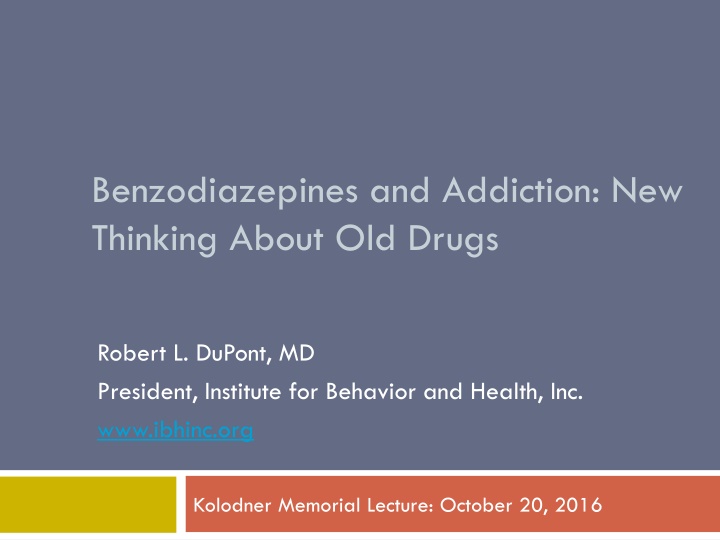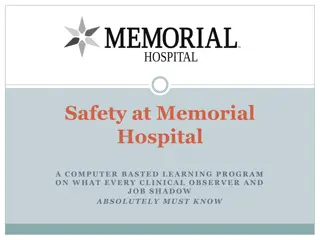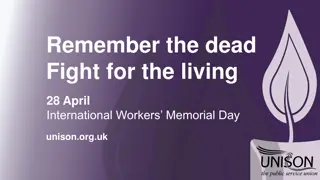
Benzodiazepine Misuse and Addiction
Explore the complex relationship between benzodiazepines and addiction, learning to differentiate between physiological dependence and addiction. Discover how benzodiazepine use intersects with substance abuse disorders and prescription practices, and gain practical strategies for safe discontinuation of these drugs. Stay informed about trends in benzodiazepine-related emergency department visits and illicit use patterns over the years.
Download Presentation

Please find below an Image/Link to download the presentation.
The content on the website is provided AS IS for your information and personal use only. It may not be sold, licensed, or shared on other websites without obtaining consent from the author. If you encounter any issues during the download, it is possible that the publisher has removed the file from their server.
You are allowed to download the files provided on this website for personal or commercial use, subject to the condition that they are used lawfully. All files are the property of their respective owners.
The content on the website is provided AS IS for your information and personal use only. It may not be sold, licensed, or shared on other websites without obtaining consent from the author.
E N D
Presentation Transcript
Benzodiazepines and Addiction: New Thinking About Old Drugs Robert L. DuPont, MD President, Institute for Behavior and Health, Inc. www.ibhinc.org Kolodner Memorial Lecture: October 20, 2016
Learning Objectives 1. Separate physiological dependence from addiction in benzodiazepine use 2. Distinguish typical patterns of benzodiazepine use by anxious patients with and without substance use disorders 3. Relate benzodiazepine use, with and without prescriptions, to addiction treatment 4. Identify practical strategies for benzodiazepine discontinuation
Introduction to Benzodiazepines Benzodiazepines (BZs) are the most frequently cited co- intoxicants involved in opioid-related morbidity and mortality In 2010, the CDC reported 16,651 pharmaceutical opioid-related overdose deaths based on death certificate data almost one of every three opioid- related deaths in 2010 also involved BZs In 2010, hospital emergency departments in the US treated an estimated 345,691 patients for BZ misuse/abuse (Hwang, et al., 2016; Jones, Mack & Paulozzi, 2013; DEA 2013)
Estimated number of emergency department (ED) visits involving benzodiazepines alone or in combination with opioids or alcohol, by year (patients aged 12 and older): 2005 to 2011 (SAMHSA, 2014)
A Flat Trend Line Past Month Illicit Use of Pain Relievers and Tranquilizers, by Year, by Percentage of Persons Aged 12 or Older, 2002-2014 2.5 2.1 2.1 2.1 2 2 1.9 1.9 1.9 1.9 2 1.8 1.7 1.7 1.6 1.5 Percent 0.9 1 0.8 0.8 0.8 0.8 0.7 0.7 0.7 0.7 0.7 0.7 0.7 0.6 0.5 0 2000 2002 2004 2006 2008 Year 2010 2012 2014 2016 Pain Relievers Tranquilizers (CBSHQ 2015a)
Trends in 30-day Prevalence of Use of Tranquilizers, Percentage of Respondents, by Year 3.5 3.3 8th Grade 3.1 2.9 2.9 10th Grade 3 2.8 2.7 2.7 2.6 2.6 2.6 12th Grade 2.5 2.4 2.4 2.5 2.3 2.3 2.3 2.2 2.1 2.1 2 2 2 1.9 1.9 Percent 2 1.7 1.7 1.6 1.6 1.4 1.5 1.3 1.3 1.2 1.2 1.2 1.2 1.2 1.1 1 0.9 1 0.8 0.8 0.8 0.5 0 2000 2002 2004 2006 2008 2010 2012 2014 2016 Monitoring the Future is an ongoing study of the behaviors, attitudes, and values of school students and young adults. Each year, a total of approximately 50,000 students in 8th, 10th and 12th grades are surveyed for, among other things, use of pharmaceutical drugs without a doctor telling you to use them. Several illicit drugs showed declines in use in 2015. There were declines in students use of MDMA (ecstasy, Molly), heroin, synthetic marijuana ( K2, Spice ) and amphetamines. In 2015, there were no statistically significant increases for any of the more than 50 classes and subclasses of drugs, including tranquilizers, that MTF tracks. (Johnston, et al., 2015)
National Private Sector Data A large study of 3+ million physician-ordered laboratory tests conducted in 2015 showed that 54% showed drug misuse Of those, 45% showed evidence of use of one or more drug in addition to prescribed drugs a dramatic increase from 35% in 2014 A critical finding because combinations of drugs, e.g., opioids and sedatives, can result in severe consequences Drug use that is unknown to prescribing physicians can have serious impact on patients (Quest Diagnostics, 2016)
Treatment Admissions, Aged 12 and Older, by Primary Substance of Abuse, 2003-2013 TEDS is maintained by SAMHSA s Center for Behavioral Health Statistics and Quality 25,000 20,000 Includes records for substance abuse treatment admissions reported by state-run treatment facilities Number of Admissions 15,000 10,000 In 2013, TEDS collected data on 1.74 million admissions of which benzodiazepines accounted for 0.9% of all admissions by primary substance of abuse 5,000 0 2003 2004 2005 2006 2007 2008 2009 2010 2011 2012 2013 Tranquilizers Benzodiazepines Other tranquilizers (CBHSQ 2015b)
Before the BZs Alcohol Opium Then in 1903 the barbiturates Wonderful at first then addiction and overdose deaths
Hoffman-La Roche A tweak and we had Librium the BZ Grandfather in 1955, marketed in 1960 A tamed cat that did not stagger Valium came in 1963 (when I graduated from medical school)
Four BZ Effects Reduced anxiety/fear Reduced insomnia Reduced muscle spasm Reduced seizures From Hoffman-LaRoche: Valium, Dalmane and Klonopin A new era of psychopharmacology most widely prescribed drugs in the world
Trouble in BZ Paradise Like barbiturates before them, the BZ miracle had serious costs Addiction booze in a pill Concerns over long-term effects falls in the elderly, automobile crashes, cognitive impairment More recently, overdose deaths not alone but in combination
BZs in My Two Medical Lives Addiction medicine starting in 1968 BZs a common threat an unwelcome descendent of the barbiturates Anxiety disorders starting in 1978 BZs a uniquely useful medicine with few problems
Patients Tell Physicians Which Group They Are In Without Words Addicted Patients: High BZ doses that escalate over time Use BZs with alcohol and other drugs not alone but to boost effects of other drugs Non-Addicted Anxious Patients: Low and stable doses Don t drink much and don t use other drugs It ain t rocket science usually
Addiction vs. Physical Dependence Addiction Continued use despite often serious behavioral problems Lying, dishonesty Physical dependence Tolerance to drug effects and reversal of effects on abrupt discontinuation No behavioral problems and no dishonesty
How to Treat? Treatment of addiction: Substance abuse treatment and long-term recovery support sobriety date It s Hard! Treatment of physical dependence: Gradual dose reduction and management of the return of the symptoms that were being treated (e.g., anxiety, insomnia, etc.) It s Easy!
Comorbid for Anxiety and Addiction Treat these dual diagnosis patients like addicts, not like non-addicted anxiety patients There are exceptions and some of them actually work out, but many don t
Treatment of Anxiety / Panic and Insomnia with Addiction Not BZ deficiency disorders Non-pharmacologic treatment of anxiety is much harder than giving a prescription for a pill
Principles of Anxiety Treatment It helps to be empathic anxiety symptoms including panic are not fatal, but they are worse because they rob you of the enjoyment of your life Anxiety disorder is a disease of quality people the overactive conscience, excessive empathy and the what if trap Acceptance is the all-purpose anxiety antidote Fearing the symptoms escalates and prolongs them Anxiety/panic is distressing but not dangerous Treating anxiety without pills is a clinical challenge
Treatment Current pattern of treatment of anxiety-absent addiction often is both an SSRI and a BZ Empathize with anxious ADDICTS who not only have to give up social drinking but also the use of BZs
Whats New Now The role of the BZs in the opioid epidemic While the BZs do not suppress respiration on their own (except with COPD) they boost the lethality of drugs that do suppress respiration including opioids and alcohol Commonly found in blood of overdose deaths which are rarely opioids alone
New Safety Measures Food and Drug Administration (FDA) announced class-wide changes to drug labeling Boxed warnings about the serious risks associated with combined use of opioid medications and BZs New medication guides for ~400 products Patients receiving both should discuss risks with their prescribing physicians
Study of Veterans Who Received Opioid Analgesics 27% of veterans who received opioid analgesics also received BZs About half of deaths from drug overdose occurred when veterans were concurrently prescribed BZs and opioids Risk of overdose death increased with history of BZ prescription Increased risk of death with increase in BZ dose Temazepam was associated with a decreased risk of death from overdose compared to clonazepam (Park, et al., 2015)
BZs in Methadone Treatment Study examined the relationship between in- treatment illicit drug use and retention and dropout of 604 MMT patients in Washington, DC Those testing positive were three times more likely to leave treatment than those who did not test positive Testing positive for one drug doubled the rate of attrition; testing positive for multiple drugs quadrupled the risk of attrition (White, et al., 2015)
Some Puzzling Findings Drug Test Result Patients Number Percent Dropping Out Odds Ratio (95% CI) p-value Benzodiazepine Not Prescribed 38 16 42% 6.5 (3.2 13.5) <.001 Benzodiazepine Prescribed 72 6 8% 0.8 (0.3 2.0) 0.83 (White, et al., 2015)
Prescribed vs. Non-Prescribed BZs Methadone patients who had their own prescriptions for BZs did not dropout more than the patients who did not use BZs Those who had positive urines and did not have their own prescriptions for those medicines had much higher rates of dropout This later group was younger and more male (White, et al., 2015)
A Question Why is it so common to have methadone and buprenorphine patients who take BZs with and without prescriptions and why do so few die of overdose? Two factors: tolerance and dose
Why? When the two drugs are used in stable doses, almost no matter how high apparently, overdoses do not occur (tolerance) But when they are used at higher doses, usually much higher doses, than they had been used in the prior week or two, death is all too common (dose)
Final Thoughts Getting off BZs after chronic use Medically easy gradual dose reduction over several weeks Clinically difficult because of reversal of therapeutic effects (e.g., insomnia and anxiety) With motivation it can be done Without motivation not so much
CME Question 1 Which of the following is the most frequently cited co-intoxicant in opioid overdose deaths? Alcohol Benzodiazepines Cocaine None of the above A. B. C. D.
CME Question 2 In about what percentage of all substance abuse treatment admissions in 2013 was a benzodiazepine the primary drug of abuse? 30% 20% 10% 1% A. B. C. D.
CME Question 3 Typical anxiety disorder patients without a history of abuse of alcohol or drugs commonly show which of these patterns of benzodiazepine use? Gradual dose escalation to very high doses Stable low doses over even very long periods of time Drug-seeking behavior with multiple physicians unknowingly prescribing benzodiazepines Dishonesty about their use of alcohol and other drugs A. B. C. D.
CME Question 4 In a study of veterans prescribed opioid analgesics what percent also received a benzodiazepine prescription? 7% 17% 27% 57% A. B. C. D.
CME Question 5 In a methadone treatment program for opioid addicts, what was the effect of benzodiazepine positive urine drug tests on program retention compared to patients not testing positive for benzodiazepines? For those who did not have their own benzodiazepine prescription there was no effect on retention For those with their own benzodiazepine prescriptions there was no effect on their retention For both groups there was a marked reduction in retention associated with benzodiazepine use None of the above A. B. C. D.
Thank you! Special thanks to John J. Coleman, PhD
References + Resources Center for Behavioral Health Statistics and Quality. (2015a). Behavioral health trends in the United States: Results from the 2014 National Survey on Drug Use and Health, (Table A1B); HHS Publication No. SMA 15-4927, NSDUH Series H-50. 2015. Available: http://www.samhsa.gov/data/sites/default/files/NSDUH-FRR1-2014/NSDUH-FRR1-2014.pdf Center for Behavioral Health Statistics and Quality. (2015b). Treatment Episode Data Set (TEDS): 2003-2013. National Admissions to Substance Abuse Treatment Services. Rockville, MD: Substance Abuse and Mental Health Services Administration, 2015. Available: http://www.samhsa.gov/data/sites/default/files/2003_2013_TEDS_National/2003_2013_Treatment_Episode_Data_Set _National.pdf Centers for Disease Control and Prevention. (2016, January 1). Increases in drug and opioid overdose deaths United States, 2014. CDC Morbidity and Mortality Weekly Report, 64(50):1378-82. Available: http://www.cdc.gov/mmwr/preview/mmwrhtml/mm6450a3.htm?s_cid=mm6450a3_w Drug Enforcement Administration, Office of Diversion Control. (2013, Jan). Fact Sheet: Benzodiazepines. Available: http://www.deadiversion.usdoj.gov/drug_chem_info/benzo.pdf#search=benzodiazepine%20 DuPont, R.L., Greene, W.M., & DuPont, C.M. (in press). Sedatives/hypnotics and benzodiazepines. In A. Mack, R. Frances, K. Brady (Eds.), Clinical Textbook of Addictive Disorders (4th ed.). New York, NY: Guilford. DuPont, R. L., Greene, W. M. & Lydiard, R. B. (2007). Sedatives and hypnotics: Clinical use and abuse. In B. D. Rose (Ed.), UpToDate. Waltham, MA: UpToDate. DuPont, R. L. & Gold, M.S. (1995). Withdrawal and reward: Implications for detoxification and relapse prevention. Psychiatric Annals, 25, 663-668. Hwang, C.S., Kang, E.M., Kornegay, C.J., Staffa, J.A., Jones, C.M., & McAninch, J.K. (2016). Trends in the concomitant prescribing of opioids and benzodiazepines, 2002-2014. American Journal of Preventive Medicine.
References + Resources Inter-University Consortium for Political and Social Research. (2014). National Survey on Drug Use and Health Computer- Assisted Interview Showcards and Pillcards (ICPSR 36361) Johnston, L. D., Miech, R. A., O'Malley, P. M., Bachman, J. G., & Schulenberg, J. E. (2015, December 16). Monitoring the Future High School Student Drug Survey. University of Michigan: Ann Arbor, MI. Available: http://www.monitoringthefuture.org Jones, C.M., Mack, K.A., Paulozzi, L.J. (2013). Pharmaceutical overdose deaths, United States, 2010. JAMA, 309(7): 657- 659. Park, T. W., Saitz, R., Ganoczy, D., Ilgen, M. A., & Bohnert, A. S. B. (2015). Benzodiazepine prescribing patterns and deaths from drug overdose among US veterans receiving opioid analgesics: a cohort study. BMJ, 10(Suppl 1): A48. Quest Diagnostics. (2016). Quest Diagnostics Health TrendsTM Prescription Drug Monitoring Report 2016. Available: http://questdiagnostics.com/dms/Documents/health-trends/2016_HealthTrendsReportQuestDiagnostics.pdf Substance Abuse and Mental Health Services Administration. (2014, December 18). The DAWN Report: Benzodiazepines in combination with opioid pain relievers or alcohol: greater risk of more serious ED visit outcomes. Rockville, MD: Author. Available: http://www.samhsa.gov/data/sites/default/files/DAWN-SR192-BenzoCombos-2014/DAWN-SR192- BenzoCombos-2014.pdf White, W. L., Campbell, M. D., Spencer, R. D., Hoffman, H. A., Crissman, B. & DuPont, R. L. (2014). Patterns of abstinence or continued drug use among methadone maintenance patients and their relation to treatment retention. Journal of Psychoactive Drugs, 46(2), 114-122.






















